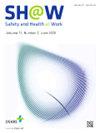Occupational Injuries Among Construction Workers by Age and Related Economic Loss: Findings From Ohio Workers' Compensation, USA: 2007–2017
IF 3.5
3区 医学
Q1 PUBLIC, ENVIRONMENTAL & OCCUPATIONAL HEALTH
引用次数: 0
Abstract
Background
This study examined age-group differences in the rate, severity, and cost of injuries among construction workers to support evidence-based worker safety and health interventions in the construction industry.
Methods
Ohio workers' compensation claims for construction workers were used to estimate claim rates and costs by age group. We analyzed claims data auto-coded into five event/exposure categories: transportation incidents; slips, trips, and falls (STFs); exposure to harmful substances and environments; contact with objects and equipment (COB); overexertion and bodily reaction. American Community Survey data were used to determine the percentage of workers in each age group.
Results
From 2007–2017, among 72,416 accepted injury claims for ∼166,000 construction full-time equivalent (FTE) per year, nearly half were caused by COB, followed by STFs (20%) and overexertion (20%). Claim rates related to COB and exposure to harmful substances and environments were highest among those 18–24 years old, with claim rates of 313.5 and 25.9 per 10,000 FTE, respectively. STFs increased with age, with the highest claim rates for those 55–64 years old (94.2 claims per 10,000 FTE). Overexertion claim rates increased and then declined with age, with the highest claim rate for those 35–44 years old (87.3 per 10,000 FTE). While younger workers had higher injury rates, older workers had higher proportions of lost-time claims and higher costs per claim. The total cost per FTE was highest for those 45–54 years old ($1,122 per FTE).
Conclusion
The variation in rates of injury types by age suggests that age-specific prevention strategies may be useful.
建筑工人职业伤害的年龄和相关经济损失:来自俄亥俄州工人赔偿的调查结果,美国:2007-2017
本研究调查了建筑工人受伤率、严重程度和成本的年龄组差异,以支持基于证据的建筑行业工人安全和健康干预措施。方法采用俄亥俄州建筑工人索赔资料,按年龄组估算索赔率和费用。我们分析了自动编码为五个事件/暴露类别的索赔数据:交通事故;滑倒、绊倒和跌倒(STFs);接触有害物质和环境;接触物体和设备(COB);过度劳累和身体反应。美国社区调查的数据被用来确定每个年龄组的工人百分比。结果从2007年至2017年,在每年接受的72,416起工伤索赔中,约有166,000建筑全职当量(FTE),其中近一半是由COB引起的,其次是STFs(20%)和过度劳累(20%)。与COB和暴露于有害物质和环境有关的索赔率在18-24岁人群中最高,分别为313.5 / 10,000 FTE和25.9 / 10,000 FTE。stf随着年龄的增长而增加,55-64岁的索赔率最高(每10,000个FTE索赔94.2个)。过度劳累索赔率随年龄的增长先上升后下降,其中35-44岁的索赔率最高(87.3 / 10,000 FTE)。年轻员工的受伤率更高,而年长员工的误工索赔比例更高,每次索赔的成本也更高。45-54岁人士的总费用最高,为1122美元。结论不同年龄损伤类型发生率的差异表明,针对不同年龄的预防策略可能是有用的。
本文章由计算机程序翻译,如有差异,请以英文原文为准。
求助全文
约1分钟内获得全文
求助全文
来源期刊

Safety and Health at Work
Social Sciences-Safety Research
CiteScore
6.40
自引率
5.70%
发文量
1080
审稿时长
38 days
期刊介绍:
Safety and Health at Work (SH@W) is an international, peer-reviewed, interdisciplinary journal published quarterly in English beginning in 2010. The journal is aimed at providing grounds for the exchange of ideas and data developed through research experience in the broad field of occupational health and safety. Articles may deal with scientific research to improve workers'' health and safety by eliminating occupational accidents and diseases, pursuing a better working life, and creating a safe and comfortable working environment. The journal focuses primarily on original articles across the whole scope of occupational health and safety, but also welcomes up-to-date review papers and short communications and commentaries on urgent issues and case studies on unique epidemiological survey, methods of accident investigation, and analysis. High priority will be given to articles on occupational epidemiology, medicine, hygiene, toxicology, nursing and health services, work safety, ergonomics, work organization, engineering of safety (mechanical, electrical, chemical, and construction), safety management and policy, and studies related to economic evaluation and its social policy and organizational aspects. Its abbreviated title is Saf Health Work.
 求助内容:
求助内容: 应助结果提醒方式:
应助结果提醒方式:


